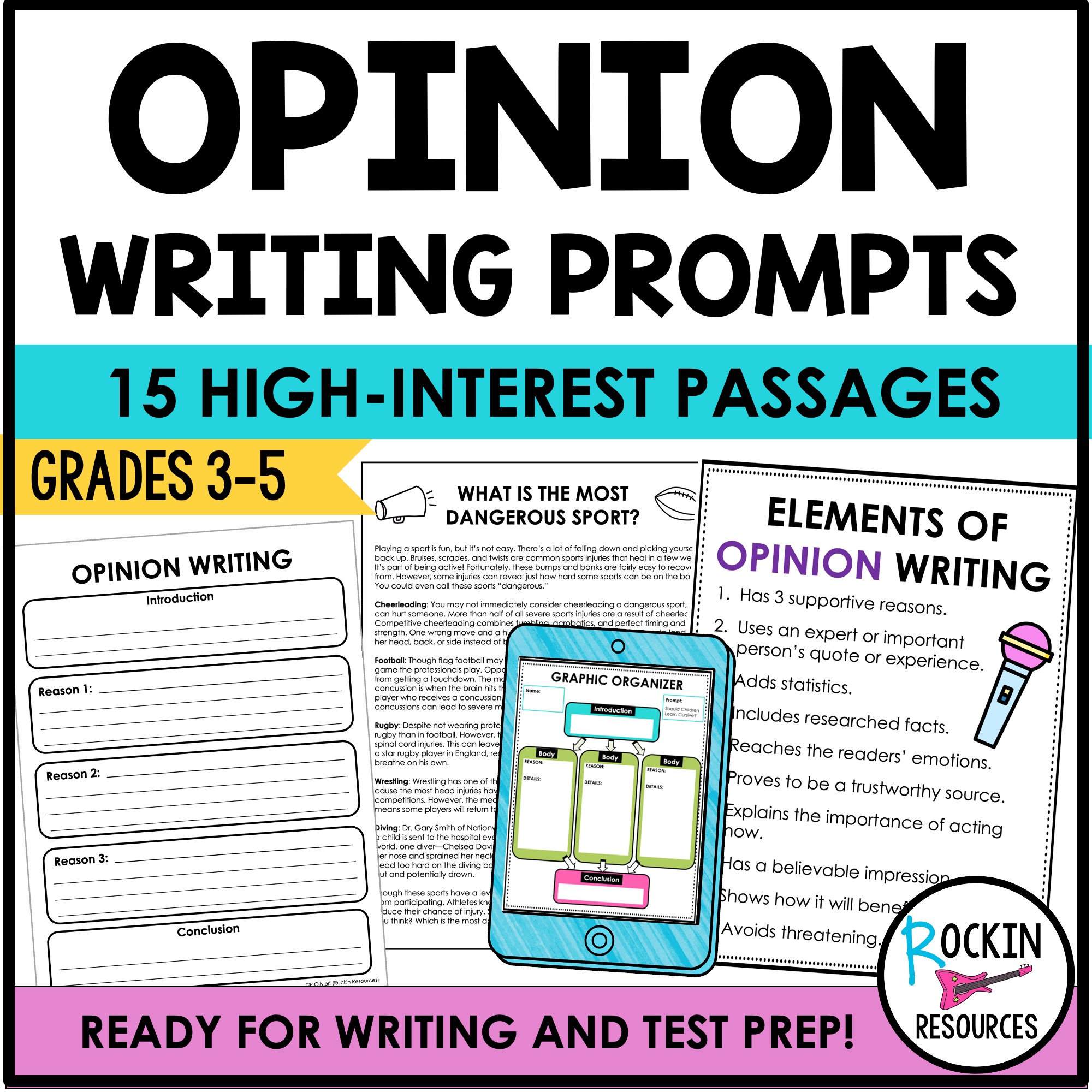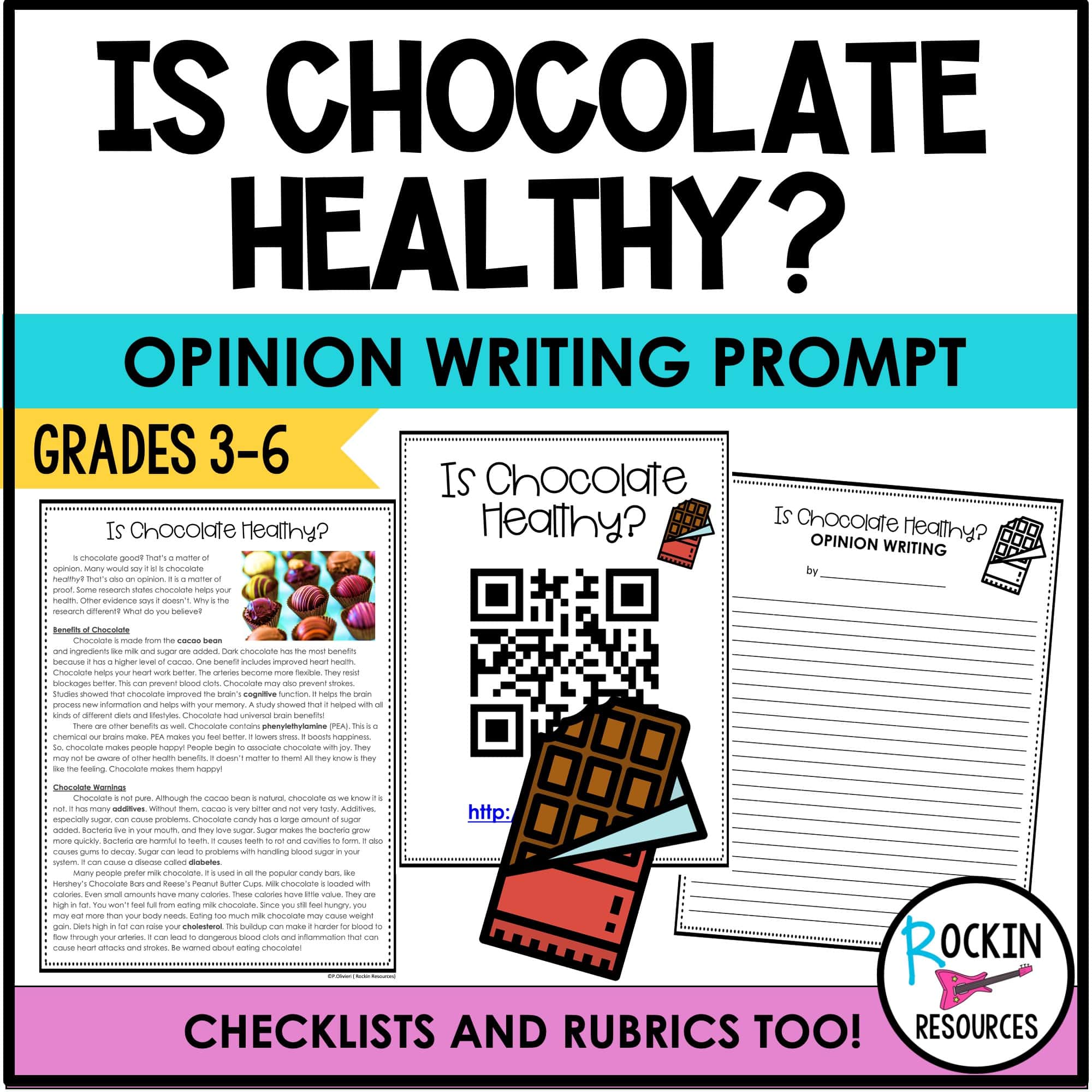Teaching OPINION WRITING can seem intimidating, but it’s really not…or maybe that’s just my opinion! :/ Here’s why: young minds have OPINIONS on almost everything! In most elementary curriculums, you will find THREE basic types of writing: Narrative, Opinion, and Informative. In this post, we’re focusing on OPINION writing; what it is, and how to teach it!
What is Opinion Writing?
Opinion writing is where students give their opinions and preferences; a chance to share their point of view about something. It’s important to include supportive reasons to strengthen an opinion. To make the point of view more credible, opinion pieces should include facts, quotes, or statistics from trustworthy sources.
When writing an OPINION piece, there are certain elements that need to be included:
- Has 3 supportive reasons.
- Uses an expert or important person’s quote or experience.
- Adds statistics.
- Includes researched facts.
- Reaches the readers’ emotions.
- Proves to be a trustworthy source.
- Explains the importance to act now.
- Has a believable impression.
- Shows how it will benefit the reader.
- Avoids threatening.
How do you teach Opinion Writing?
We’ve covered WHAT opinion writing is, now let’s learn HOW to teach it!
First, we want to explain to our students what opinion writing is and what the purpose is for writing this type of text. The author’s purpose for opinion writing is to share a point of view, so explain that they need to be provide detailed supportive reasons for their opinion. This will make their opinion powerful and believable.
Then teach mini-lessons throughout the writing process to build the opinion piece. Opinion writing should include:
Exciting Beginning: Yes, start off the essay by stating the opinion. However, students should write it to grab the reader’s attention! Make it exciting! Try onomatopoeia, a question, or a shocking statistic.
Body: Provide supportive reasons with details. I like my students to provide 3 reasons and give a variety of these reasons. For example, one reason could be a statistic or a quote from an expert in that field to show credibility, another could be a personal experience that leaves a believable impression, and another could be a shocking fact that reaches the readers’ emotions. Arrange them so that the strongest reason is last!
Transition Words: Add words that can help the essay flow and stay organized. For example: First of all, another reason, more importantly, in summary.
Word Choice: Use powerful words to leave a lasting impression. For example: heartbreaking, enthusastic, confident, disturbing, speechless, empowered, speechless.
Variety of Sentences: Sentences shouldn’t all start the same way. Try a variety. It shouldn’t say. He did this. He did that. He was here. He was there. Blah Blah Blah. Try starting with a describing word, a transition word, or write a question.
Creative Conclusion: Write the ending by restating your opinion one more time! Get creative. For example, include a wish or a hope, what may happen in the future, ask another question.
Example of Opinion Writing
For inspiration, I’m grabbing a July opinion writing prompt from my Monthly Writing Prompts resource.
I will use the following prompt:
National Hotdog Day is the third Wednesday in July. Are hot dogs bad for you? Why or why not?

Opinion Essay Example:
Yuck! Do you know what’s in a hotdog? Did you know that Americans purchase about 9 billion hotdogs per year? When distributed evenly, that would be like saying each American eats about 70 hotdogs within 365 days! I believe hotdogs are bad for you because they aren’t good for your heart, increase your risk for type 2 diabetes, not to mention they contain very questionable ingredients.
First of all, hotdogs are crummy for your heart. Do you realize how much sodium and saturated fat is in one hotdog? Research by foodrevolution.org says one single hotdog can contain over a quarter of your day’s sodium allowance, plus over 14 grams of fat! In comparison, the average Happy Meal from McDonald’s has about 5 grams of saturated fat. That means it would take nearly three Happy Meals to equal the amount of fat in one hotdog.
Secondly, every hotdog you eat increases your risk of type 2 diabetes. I know firsthand how dangerous diabetes can be. My cousin has type 2 diabetes and she tries to stay away from fatty foods and processed meats. Hotdogs are high in nitrates, which can damage pancreatic cells that make insulin. When my cousin is low on insulin, she has to give herself a shot to put insulin back into her body. Without insulin, our cells can’t filter glucose. This can be deadly if it’s not taken care of!
Most importantly, we don’t know exactly what we’re consuming when we eat hotdogs. Americans say they’ve found some gross and even dangerous items in their hotdogs. Things like rubber bands, silverfish, plastic, hair clumps, glass, razor blades, insects, buttons and pills have all been found inside of hotdogs! Needless to say, you may want to think twice before biting into your next hotdog.
With the information provided, I truly believe hotdogs are bad for your health. Nutrition Educator Director Susan Levin, says “Hotdogs, like cigarettes, should come with a warning label that helps racing fans and other consumers understand the health risk.” If you’re really craving a hotdog, there are healthier alternatives! You can look for hotdogs that are 100% chicken or beef, or even plant-based. Once you add all of the condiments you need, it may even taste the same as an average hotdog. It’s time to get tasty, healthier options on menus in America!
Identifying Opinion Elements
Exciting beginning: Yuck! (Used onomatopoeia!) Do you know what’s in a hotdog? Did you know that Americans purchase about 9 billion hotdogs per year? (This grabs the readers’ attention!) I believe hotdogs are bad for you. (State your opinion.)
Body 1: First of all, hotdogs are crummy for your heart. (Supportive reason.) Do you realize how much sodium and saturated fat is in one hotdog? Research by foodrevolution.org says…. (Showing credibility.)
Body 2: Secondly, every hotdog you eat increases your risk of type 2 diabetes. (Supportive reason.) I know firsthand how dangerous diabetes can be….(Showing personal experience.)
Body 3: Most importantly, we don’t know exactly what we’re consuming when we eat hotdogs. (Supportive reason.) Americans say they’ve found some gross and even dangerous items in their hotdogs. (Reaches readers’ emotions.)
Transition words: First of all, secondly, most importantly, needless to say, with the information provided, in comparison
Word Choice: believe, questionable, crummy, firsthand, deadly, gross, dangerous, healthier
Variety of sentences: Do you know what’s in a hotdog? First of all, hotdogs are crummy for your heart. With the information provided, I truly believe hotdogs are bad for your health.
Conclusion: With the information provided, I truly believe hotdogs are bad for your health. (Restate the opinion.) Nutrition Educator Director Susan Levin, says (Credibility) It’s time to get tasty, healthier options on menus in America! (Ends with a bang!)
Now that you know what opinion writing looks like, I hope you will find this post helpful! You can read more about informative and narrative writing, plus the differences among the three, by clicking BELOW!

SEE RELATED BLOG POSTS:
SEE RELATED RESOURCES:
-
1st Grade Step-by-Step Writing® Program
Original price was: $100.44.$70.00Current price is: $70.00. -
2nd Grade Step-by-Step Writing® Program
Original price was: $100.44.$70.00Current price is: $70.00. -
3rd Grade Step-by-Step Writing® Program
Original price was: $100.44.$70.00Current price is: $70.00. -
4th Grade Step-by-Step Writing® Program
Original price was: $100.44.$70.00Current price is: $70.00. -
5th Grade Step-by-Step Writing® Program
Original price was: $100.44.$70.00Current price is: $70.00. -
6th Grade Step-by-Step Writing® Program
Original price was: $100.44.$70.00Current price is: $70.00. -
INTERACTIVE STEP-BY-STEP® WRITING PROGRAM ULTIMATE BUNDLE
Original price was: $379.00.$189.00Current price is: $189.00. -
Middle School Step-by-Step Writing® Program Grades 6-8
Original price was: $100.44.$70.00Current price is: $70.00. -
Opinion Writing Mini Lesson Videos | Distance Learning
Original price was: $49.99.$29.99Current price is: $29.99. -
Opinion Writing Prompts Bundle
Original price was: $14.00.$6.00Current price is: $6.00. -
STEP-BY-STEP DIGITAL WRITING PROGRAM FOR MIDDLE SCHOOL
Original price was: $100.44.$70.00Current price is: $70.00. -
Step-by-Step Opinion Writing
$19.99 -
Upper Elementary STEP-BY-STEP WRITING® Grades 3-5
Original price was: $100.44.$70.00Current price is: $70.00.
SHARE THIS POST ON PINTEREST:


























